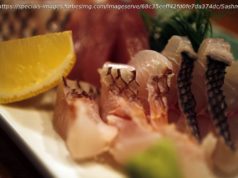Since 1963, Restaurant Nippon in Midtown has used its décor and its cooking to make a case for the Japanese way.
Remember sukiyaki?
The details were hazy in my mind until a few weeks ago, when a woman sheathed in a kimono carried a pot of it to my table at Restaurant Nippon on East 52nd Street. There it was: the onions, shiitake caps, bok choi stems, tofu blocks and the frizzy mop of noodles under a cloud of steam. The thin slices of beef going from red to pale pink. The hot broth that is based on soy and mirin but that strangely, magically tastes like French onion soup. The raw egg that, thanks to some long-forgotten cook’s flash of greatness, serves as a dipping sauce.
This refresher course would have been unnecessary if I’d made myself a regular at Nippon years ago. The restaurant opened in August 1963, a few doors west of its current address, and has offered sukiyaki since the beginning. That summer radios across the country were playing “Sukiyaki,” Kyu Sakamoto’s oblique protest song that sounded like a love song but was, in the United States, renamed after beef stew for the simple reason that it was one of the few Japanese words almost all Americans knew. The dish was that popular.
For modern New Yorkers who chase Japanese thrills at Shuko, Uchu, Tetsu and other restaurants that look and act like cocktail bars, Restaurant Nippon might seem anachronistic — Kyu Sakamoto in a Cardi B world. Over the years, though, it has served as an unofficial cultural ambassador, using its dining room and its menu to make a case for the Japanese way.
The restaurant is designed in the shoin style of a traditional Japanese house. Surrounding a main dining room with Western tables and chairs are the private zashiki rooms where shoes are left outside, floors are hidden under tatami mats and servers materialize at the sliding doors with the push of a button. Many details, like the wallpaper that evokes the opulently stylized folding screens painted by Ogata Korin, are lovely. A few, like the drop ceilings, could use attention.
Nippon introduced or championed so many dishes that today the menu preserves the recent history of Japanese food in the United States, the way the rocks of certain canyons in the West record the history of the prehistoric world.
Tora fugu, the potentially toxic tiger puffer fish, made its first regular appearance outside Japan at Nippon in 1989, when the owner, Noboyushi Kuraoka, finally prevailed in his yearslong campaign lobbying the Japanese and American governments to allow importation of the fish. Mr. Kuraoka died in January; now the restaurant is in the hands of Yasuhiro Makoshi, the manager for more than 40 years, and Akira Azuma, who has been the chef for almost that long, and it probably remains the best place in town to try fugu.
As sashimi, fanned out in transparently thin slices, it is lean and very firm, like fluke but slightly richer. Nippon sends it out with chives and a spicy daikon mash, which complement its quiet flavor, and cooked fragments of fugu, which don’t.
The least expensive serving, what is called a “half portion” for $70, is just big enough to give four people a couple of bites each. If I were going to spend money on fugu again, though, I would make a beeline for the sperm sacs, or shirako. Barely broiled, either plain with salt crystals or brushed with a miso glaze, Nippon’s shirako is as smooth and thick as fudge, with a flavor that recalls buttered crab meat, among other things.
Many firsts have been claimed by or on behalf of Nippon. Some of them may be true. Did it have the first sushi counter in New York? I am not convinced. In a 1963 Times review, Craig Claiborne wrote that Nippon had a tempura counter where sushi, “the traditional service of raw fish,” was also available. Today the sushi is respectable, if not on its own a reason to visit.
Is it a fact that no other New York restaurant was making soba noodles in 1988, when Nippon began to do so? Certainly few places have gone to the same lengths in pursuit of soba as Nippon, which imported not just buckwheat seeds but also a buckwheat farmer from Japan, and planted both in a field outside Montreal. (For years the farm also supplied a sister restaurant, Soba Nippon, now closed.)
Restaurant Nippon’s soba noodles are nutty, bouncy, springy, slightly rough and very good. I like them chilled, dunked in ponzu. Against my better judgment I even like the odd, Americanized soba salads, with a pile of noodles and meat or tofu on a platter with a fistful of lettuce.
The custom-farmed buckwheat also goes into an astoundingly good thing called soba miso that comes smeared on a small wooden paddle. A black sludge of fermented buckwheat studded with buckwheat kernels, it looks like brownie batter and tastes a little like chocolate, too, as well as roasted nuts and espresso and cooked mushrooms.
Whether negimaki was invented at Nippon or simply made its first United States appearance there, it’s hard to see why tough beef wrapped around undercooked scallions captured America’s imagination. More intriguing is another original, beef oroshi, essentially shabu except that it is cooked offstage and you get nothing but meat and broth with some spicy grated daikon.
This is also the birthplace of agedashi mozzarella. If you have ever wondered what fried cheese in dashi would taste like, you will find the answer here.
The backbone of the menu, though, is traditional Japanese food, nearly all of it good and some of it better than that. There is fluke for those who won’t pay up for fugu, and it is just what you’d want it to be. Broiled eel over rice makes a wonderfully soothing meal.
The kamonabe is a duck hot pot cooked over a burner set on the table. The duck may not be entirely tender, but it is flavorful. The broth is a symphony. For scale, theatricality and deeply reassuring flavor, its only rival is the sukiyaki, but the kamonabe comes with a dividend: a bowl of rice cooked in the leftover broth as a second course.
Follow NYT Food on Facebook, Instagram, Twitter and Pinterest. Get regular updates from NYT Cooking, with recipe suggestions, cooking tips and shopping advice.






